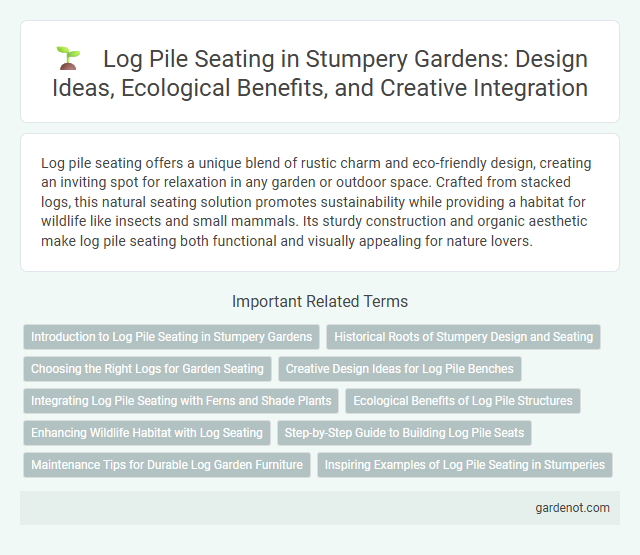Log pile seating offers a unique blend of rustic charm and eco-friendly design, creating an inviting spot for relaxation in any garden or outdoor space. Crafted from stacked logs, this natural seating solution promotes sustainability while providing a habitat for wildlife like insects and small mammals. Its sturdy construction and organic aesthetic make log pile seating both functional and visually appealing for nature lovers.
Introduction to Log Pile Seating in Stumpery Gardens
Log pile seating in stumpery gardens offers a natural, rustic resting spot crafted from stacked logs and branches, seamlessly blending with woodland environments. This eco-friendly seating solution promotes biodiversity by providing habitats for insects and fungi while enhancing the garden's textured, organic aesthetic. Its sturdy structure supports durable outdoor use, making it an ideal feature for woodland or stumpery garden designs seeking sustainable and visually appealing furniture.
Historical Roots of Stumpery Design and Seating
Log pile seating in stumpery design traces its origins to Victorian England, where gardeners creatively repurposed tree stumps, logs, and branches to craft naturalistic garden features. These rustic seatings not only showcased an appreciation for woodland aesthetics but also emphasized sustainability by reusing organic materials. The historical roots highlight a blend of functionality and artistry, reflecting a deep connection to nature and traditional gardening practices.
Choosing the Right Logs for Garden Seating
Selecting the right logs for log pile seating involves choosing hardwood varieties like oak, walnut, or maple, which offer durability and resistance to decay. Ensure logs are well-seasoned and free from excessive moisture to prevent rotting and support long-lasting garden furniture. Properly sized logs, ideally between 12 to 18 inches in diameter, provide stable and comfortable seating surfaces for outdoor spaces.
Creative Design Ideas for Log Pile Benches
Log pile seating transforms natural wood stacks into functional outdoor benches, blending rustic aesthetics with sustainable design. Creative design ideas include incorporating varied log diameters to create textured surfaces, integrating live-edge slabs for comfort, and embedding moss or small plants within gaps to enhance organic appeal. This approach not only recycles timber but also adds unique, eco-friendly charm to garden landscapes.
Integrating Log Pile Seating with Ferns and Shade Plants
Log pile seating creates a natural, rustic focal point in shaded garden areas, perfectly complementing the lush textures of ferns and shade-loving plants. Using durable hardwood logs, the seating blends seamlessly into the stumpery, enhancing biodiversity by providing habitats for insects and mosses around the base. Positioning the log pile amidst shade plants like maidenhair ferns and hostas enriches the garden's layered, woodland aesthetic while promoting moisture retention and soil health.
Ecological Benefits of Log Pile Structures
Log pile seating supports biodiversity by providing habitats for insects, fungi, and small mammals, enhancing garden ecosystems. The natural decomposition process of logs enriches soil quality and promotes nutrient cycling, fostering healthier plant growth. Utilizing log piles as seating reduces reliance on manufactured materials, lowering environmental impact and encouraging sustainable garden design.
Enhancing Wildlife Habitat with Log Seating
Log pile seating creates essential microhabitats by providing shelter and nesting sites for insects, amphibians, and small mammals. Incorporating varied wood types and sizes promotes biodiversity, supporting species like beetles, spiders, and hedgehogs. This natural seating option not only offers functional use but also significantly enhances the local wildlife ecosystem.
Step-by-Step Guide to Building Log Pile Seats
Start by gathering sturdy logs of varying lengths and diameters to create a stable foundation for the log pile seating. Arrange the logs horizontally in a layered pattern, interlocking them securely to form a solid base, while placing the largest logs at the bottom for maximum support. Finish by positioning a flat, wide log or wooden plank on top to serve as a comfortable seating surface, ensuring stability and durability for outdoor use.
Maintenance Tips for Durable Log Garden Furniture
Log pile seating requires regular inspection for moisture damage and pests to ensure longevity. Treating the wood with weather-resistant sealants and applying natural preservatives can prevent rot and insect infestation. Elevating the seating slightly off the ground improves drainage, reducing the risk of wood decay in garden environments.
Inspiring Examples of Log Pile Seating in Stumperies
Log pile seating in stumperies creates rustic, eco-friendly resting spots by creatively stacking logs to form benches or chairs. Notable examples include the Highgrove Stumpery in the UK, where curving log arrangements blend seamlessly with native plants, and the Denver Botanic Gardens showcasing sculptural seating that enhances woodland aesthetics. These inspiring designs emphasize sustainability and natural integration, offering functional art that invites relaxation amidst organic textures.
Log pile seating Infographic

 gardenot.com
gardenot.com